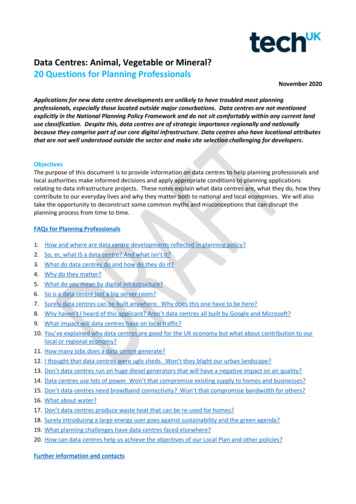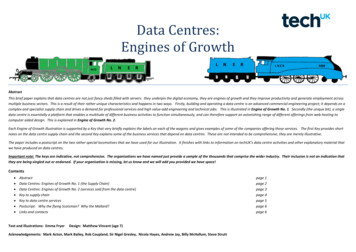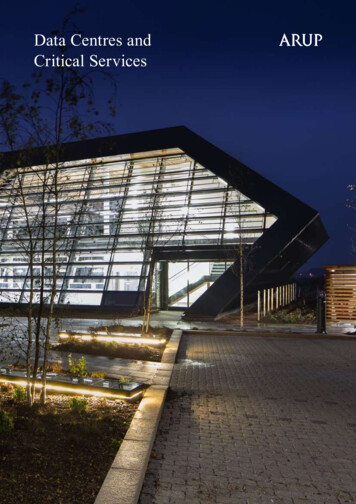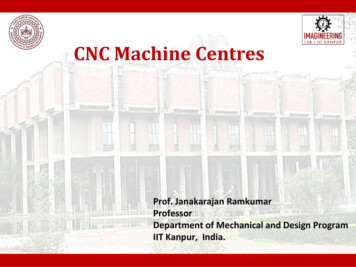
Transcription
Data Centres: Animal, Vegetable or Mineral?20 Questions for Planning ProfessionalsNovember 2020Applications for new data centre developments are unlikely to have troubled most planningprofessionals, especially those located outside major conurbations. Data centres are not mentionedexplicitly in the National Planning Policy Framework and do not sit comfortably within any current landuse classification. Despite this, data centres are of strategic importance regionally and nationallybecause they comprise part of our core digital infrastructure. Data centres also have locational attributesthat are not well understood outside the sector and make site selection challenging for developers.ObjectivesThe purpose of this document is to provide information on data centres to help planning professionals andlocal authorities make informed decisions and apply appropriate conditions to planning applicationsrelating to data infrastructure projects. These notes explain what data centres are, what they do, how theycontribute to our everyday lives and why they matter both to national and local economies. We will alsotake the opportunity to deconstruct some common myths and misconceptions that can disrupt theplanning process from time to time.FAQs for Planning Professionals1.2.3.4.How and where are data centre developments reflected in planning policy?So, er, what IS a data centre? And what isn’t it?What do data centres do and how do they do it?Why do they matter?5.6.7.8.What do you mean by digital infrastructure?So is a data centre just a big server room?Surely data centres can be built anywhere. Why does this one have to be here?Why haven’t I heard of this applicant? Aren’t data centres all built by Google and Microsoft?9. What impact will data centres have on local traffic?10. You’ve explained why data centres are good for the UK economy but what about contribution to ourlocal or regional economy?11. How many jobs does a data centre generate?12. I thought that data centres were ugly sheds. Won’t they blight our urban landscape?13. Don’t data centres run on huge diesel generators that will have a negative impact on air quality?14.15.16.17.18.19.20.Data centres use lots of power. Won’t that compromise existing supply to homes and businesses?Don’t data centres need broadband connectivity? Won’t that compromise bandwidth for others?What about water?Don’t data centres produce waste heat that can be re-used for homes?Surely introducing a large energy user goes against sustainability and the green agenda?What planning challenges have data centres faced elsewhere?How can data centres help us achieve the objectives of our Local Plan and other policies?Further information and contacts
FAQs for planning professionalsThe UK’s data centre sector quietly underpins an internet economy that contributes over 16% of domesticoutput, 10% of employment and 24% of total UK exportsi. The UK’s strength as leader and net exporter ofdigital services depends on state-of-the-art digital infrastructure that is secure, efficient, reliable andcompetitive. It also depends, now and in the future, on adequate capacity, both in terms of datainfrastructure (data centres) and connectivity (telecommunications networks). From a policy perspective,the successful delivery of a multitude of initiatives, from the Digital Strategy to the Levelling Up agenda,are heavily reliant on world-class data infrastructure.Q1How and where are data centre developments reflected in planning policy?At time of writing, neither data infrastructure (the term for data centres currently in use among policymakers) nor data centres are explicitly referenced in the latest iteration of the National Planning PolicyFramework. However, data centres are directly relevant to section 10 (supporting high qualitycommunications) so this is their home within the document. From a strategic planning perspective, datacentres, combined with fixed and mobile telecommunications networks, comprise digital infrastructure.However, other provisions within the NPPF are relevant, such as Section 6 (building a strong andcompetitive economy). Data centres and the ecosystem of data-dependent companies that tend todevelop around them represent those high tech clusters that planners are urged to accommodate. Thesector has also proved astonishingly resilient to the challenges of COVID-19: operators have been able topay rent and rates on time and the sector is not associated with redundancies or furlough. Section 7(Ensuring the vitality of town centres) is also pertinent to data centres which are usually located on tradingestates and will not impact local traffic or draw consumer trade away from town centres. In this capacitydata centres, typically brownfield development on post-industrial sites, also support the provisions ofSection 11 (promoting effective use of land).Q2So, er, what IS a data centre? And what isn’t it?A data centre is a building (or self-contained unit within a building) that houses computing equipment(primarily servers) along with associated components such as telecommunications, network and storagesystems. A data centre is equipped with a guaranteed power supply and high bandwidth connectivity.Resilience is critical, so redundancy (duplication) of networks, power and other infrastructure is common toensure continuity. Building management controls such as air conditioning maintain the environmentalconditions for the equipment within a specified envelope of temperature and humidity, and advancedsecurity systems ensure that the facility and its data remain secure1.A data centre is not affordable housing, it does not manufacture a product, it is not a supermarket and,perhaps disappointingly for some, it is not there to spy on people, provide shelter in the event of a zombieapocalypse or generate Death Rays. In the simplest possible terms it houses computers to process data atindustrial scale. The by-product is usually warm air.Q3And what do data centres do?Data centres receive, process, manage, store and transmit digital data and comprise part of our core digitalinfrastructure. Telecommunications rely on data centres and data centres rely on telecommunications.Every time we read a post on Facebook, order our shopping from Sainsbury’s, get directions for a journey,download a film, send an email or check the weather forecast, a data centre is involved. In fact, a singletransaction usually depends on many data centres interacting – not just one. The image in Endnote A setsout how data centres work as part of our communications infrastructure. It is data centres that enable1See our publication Er, What IS A Data Centre?
supermarkets to resupply, retailers and banks to process financial payments, delivery companies to managelogistics and government to deliver services. It is data centres that keep businesses running remotely andallow government to communicate during COVID-19 lockdowns. Data centres are the physicalmanifestation of our digital economy: we cannot lead connected lives without data centres. See ourEndnote A for infographics explaining how the internet works.Q4What do you mean by digital infrastructure?We all know what physical infrastructure is – roads, rail,bridges, ports, airports, utilities. We need infrastructureto support communities and for the economy to function.Digital infrastructure is the same, but instead of allowingthe movement of lorries or trains or water or electricity, itfacilitates the flow of data – on which everything elseincreasingly depends (including the operation of all thosephysical infrastructure sectors listed above!). Digitalinfrastructure comprises data infrastructure (datacentres) and multiple interlocking telecoms networks (communications), which provide connectivity.Economic growth depends on modern infrastructure, both digital and physical, but digital infrastructure is afar more powerful driver of growth than physical infrastructure 2.Q5And why do data centres matter?The internet, and all the economic productivity of the digital economy, does not float in a cloud but sitssecurely on servers in data centres. Although most people have never heard of it, the UK’s data centresector is a real success story, is globally important and leading edge in terms of technology and expertiseand delivering year on year growth. Data is as important to our economy as concrete or steel – and it isdata centres that are the physical manifestation of our digital economy and enable the UK to punch wellabove its weight in digital exports and services. UK facilities provide the technical infrastructure forfinancial services, aerospace, transport, healthcare, retail, utilities, academic research and entertainment.Data centres are the critical infrastructure that will enable the UK to be world-leading in green technologiesand services. Each new data centre contributes between 397 M and 436 M GVA per year to the UKeconomy3 while the contribution of each existing data centre is estimated to lie between 291 M and 320M per annum. Data centres are where our industrial strategy meets our digital strategy. You can find outmore about the UK’s data centre market from our Sector Overview4.Q6So is a data centre just a big server room?Er, yes and no. If you work for a local authority you may be familiar with what we call “on-premise IT” inthe form of server cupboards and server rooms, some of which may be large enough to be described asdata centres. At a superficial level, yes, a data centre is a larger version of one of these – an environmentwhere the IT functions that support an organisation are housed. That’s probably where the similarity ends,though. A commercial data centre is usually purpose-built and houses IT functions for any number of thirdparty customers – sometimes for hundreds of different organisations, sometimes designed and builtbespoke for a single large customer. It provides guaranteed levels of security, connectivity and, usually,operational efficiency. It benefits from economies of scale in terms of energy purchasing, energystewardship and environmental controls like cooling systems. If you want to understand why peoplechoose to outsource their core IT functions to data centres, have a look at Endnote B.Q7Surely data centres can be built anywhere. Why does this one have to be here?2There is a plethora of reports on digital infrastructure as a driver of growth. Examples tructure-driver-competitiveness nfrastructure/3See: https://www.digitalrealty.com/data-economy4The Most Important Sector You’ve Never Heard of: UK Data Centre Sector Overview 2020
Data centres are thought to be location agnostic but this only applies to certain types of operation,simplistically those that provide services like email that do not rely on very fast response speeds (we callthis low latency). So large cloud operators are developing sites in Scandinavia, where there is available landand cheap renewable power. In the UK the requirement tends to be much more specific. Data centres havelocational attributes, with complex needs in terms of site characteristics. As a result, suitable plots for datacentre development are extremely hard to find. UK operators and developers will therefore have investedsignificant time and resource in site selection before they start a planning application. Unlike residentialdevelopments, where planning permission may be sought more speculatively and plots with consent maynever be developed, data centre applications are made from a position of immediate need.Q8Why haven’t I heard of this applicant? Aren’t data centres all built by Amazon and Google?To date, no data centres in the UK have been developed by these large cloud providers, although thissituation is likely to change soon. Until that happens, they represent a large and important customer basefor commercial data centre operators that you won’t have heard of like Vantage, VIRTUS, CyrusOne andArk. See Endnote B for a data centre services map that shows what these and other operators do.Q9What impact will data centres have on local traffic?Data centre have marginal impact on local traffic. Daily footfall to facilities is low compared to distributionwarehouses, manufacturing or office developments and negligible compared to retail outlets. Shiftpatterns apply to most staff. Vendors, customers and operational staff will need to access the site andnumbers will vary depending on the type of data centre, the number of customer organisations operatingwithin it and the kind of activity it is supporting. Vehicles tend to be private cars or small vans. Occasionalvisits from tankers to top up storage tanks should be expected and very occasionally, large plant may turnup to be installed but the latter will be rare events. The commonly imposed requirement for large carparking capacity in anticipation of future change of use is therefore not appropriate. When we compiledfootfall data about facilities numbers varied from about a dozen to around 100 individuals during a 24 hourperiod. However, we would anticipate more footfall for sites that share premises with corporate offices.Q10So data centres are good for the UK economy but what about our local or regional economy?This is a good question and the answer is that data centres can have a transformational impact on localeconomies. Take Lulea in Sweden, a post-industrial area previously known for forestry and mining, thaturgently needed to reinvent itself as traditional industries declined. The regional authority attracted datacentre operators, most notably Facebook, whose large site generated 900 jobs, 225M in domesticspending and over 500M in overall economic impact5. Lulea also hosts a technical university and aresearch hub and has emerged as a world class centre of excellence – all within less than a decade.Q11How many jobs does a data centre generate?It depends on whether you mean construction or operation and direct or indirect. Data centres areadvanced technical infrastructure with construction costs usually in hundreds of M. These are high valueprojects providing employment for specialist construction and engineering teams. Once operational, datacentres generate high value add jobs within the local area, primarily in STEM roles like engineering design,network engineering, IT, facility management, energy stewardship, regulatory compliance, business andtechnical operations management. Ancillary jobs include security, reception, cleaning and other familiarcorporate support roles. While data centres generate hundreds of jobs directly in construction, and dozensin operation, they are far more powerful drivers of indirect employment and broader economic growth5Boston Consulting, 2014: conomic-Development-Jun-2014Nordics tcm22-29049.pdf
because the digital capacity they provide supports multiple layers of economic activity6 and comprises partof our core digital infrastructure.7Q12I thought that data centres were ugly sheds. Won’t they blight our urban landscape?It’s true that data centres can be nondescript -they are after all, the modern equivalent of industrialfacilities so they are primarily functional, built to deliver operational efficiency rather than aestheticpleasure. In some cases it can also be helpful from a resilience perspective for these facilities to blend intothe built environment and not stand out too much. However, while engineering design must lead, datacentres come in many shapes and sizes: see the images below, from left, Equinix in Amsterdam, Switch inMichigan, and AQL in Leeds. Images sourced from DCD (DataCenterDynamics).Data centres also tend to have large items ofmechanical and engineering plant on site and it wouldbe reasonable to request that this is screened fromstreet view, in the interests of aesthetics. We are alsostarting to see green walls and roofs applied tostatement buildings in city centres (see image of adata centre in Hong Kong- source Sempergreen).Outside city centres, initiatives are more likely to beaimed at biodiversity rather than aesthetics, forexample in Ireland where developers have funded andimplemented bee-friendly planting8.Q13Don’t data centres run on huge diesel generators that have a negative impact on air quality?Data centres run exclusively on electricity but they do install emergency generating capacity to providepower in the event of grid failure. In the UK grid outages are fortunately very rare and the majority offacilities have never run their generators in anger. They do need to test them regularly (usually for about30 minutes a month), but testing routines can be timed to minimise local impacts and generator operationis highly regulated through MCPD (Medium Combustion Plant Directive) and for larger sites, IED (IndustrialEmissions Directive), both of which are implemented through EPR (Environmental Permitting Regulations)in the UK. These regulations effectively prevent elective operation (which means that the generatorscannot be used other than for testing or emergency). Data centre contribution to national NOX levels isnegligible but facilities do have the potential to affect local air quality for short periods in the event that thegrid is compromised.9 Hence the very tight controls that already apply and planners need to be wary ofapplying additional conditions that are not aligned with those already imposed and enforced by theEnvironment Agency. This avoids the likelihood of contradictory requirements being imposed ondevelopers.6See Data Centre: Engines of GrowthWorld Economic Forum on digital infrastructure:http://www3.weforum.org/docs/WEF TC DeliveringDigitalInfrastructure InternetEconomy Report 2014.pdf8See: -for-bees79For more information see: NOX: Implications for Data Centres and Emergency Generation in Data Centres
Q14Data centres use lots of power. Won’t that compromise existing supply to homes and businesses?Data centres do indeed use lots of power (commercial facilities in the UK collectively use 3TWh a year) anddata centre developments can only proceed where there is adequate electricity supply for their needs.Developers and operators have to provision power on the basis of maximum predicted demand that theycan impose on the electricity supply in future - once the site is fully developed and working at full capacity.Since data centres are built incrementally they may never reach this threshold. This provisioning takes theform of a formal agreement with the electricity provider and means that properly planned data centrescannot encroach on existing supply to homes and businesses. It is not uncommon for data centres to fundor co-fund additional power infrastructure like electricity sub-stations to guarantee resilience and it is fairto say that by so doing they are also improving the local power infrastructure. Data centres also haverelatively stable and predictable power requirements and peak demand is likely to occur on hot days, wellout of synch with national peak demand cycles. There is also potential for data centres to be anchorcustomers of local low carbon generation - for instance energy from waste.10Q15Don’t data centres need broadband connectivity? Won’t that compromise bandwidth for others?Data centres need very high connectivity, and usually from multiple sources, but this is contracted directlyfrom service providers. Rather like electricity, such moves to upgrade connectivity to meet the needs ofoperators are more likely to improve local infrastructure than consume capacity - particularly if there is aregional drive to attract data centre inward investment or a large scale development proposed.Q16What about water?Data centres commonly use water for cooling and water usage effectiveness (WUE) is a performance metricdeployed increasingly within the industry. Newspapers occasionally rep
Data centres receive, process, manage, store and transmit digital data and comprise part of our core digital infrastructure. Telecommunications rely on data centres and data centres rely on telecommunications. . Ark. See Endnote B for a data centre services map that shows what these and other operators











